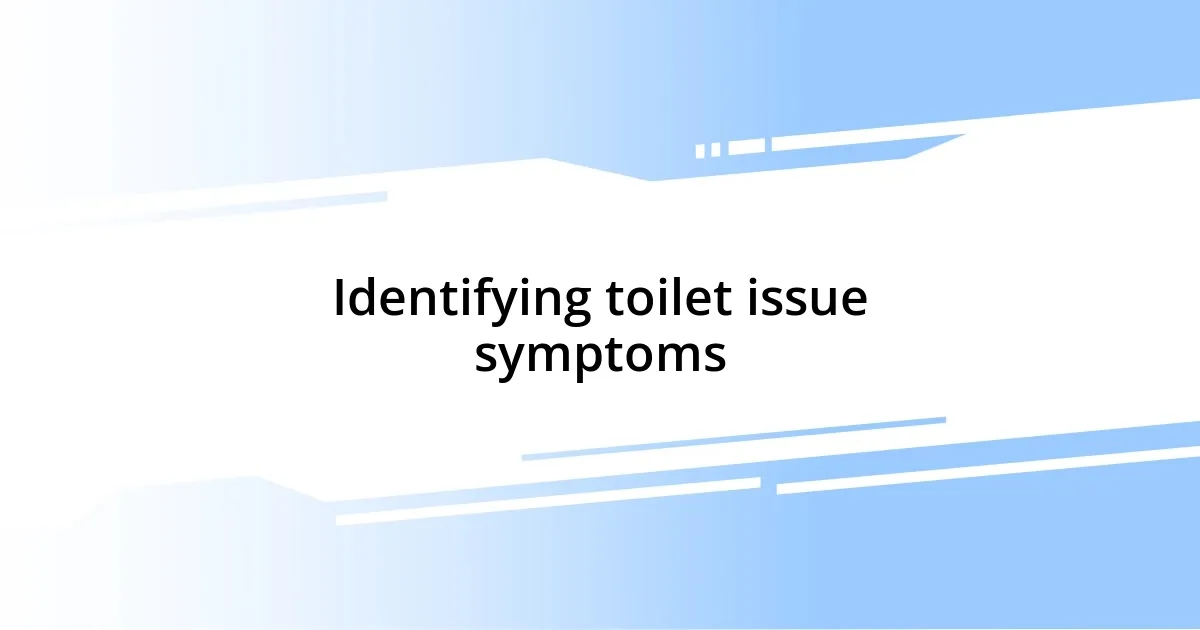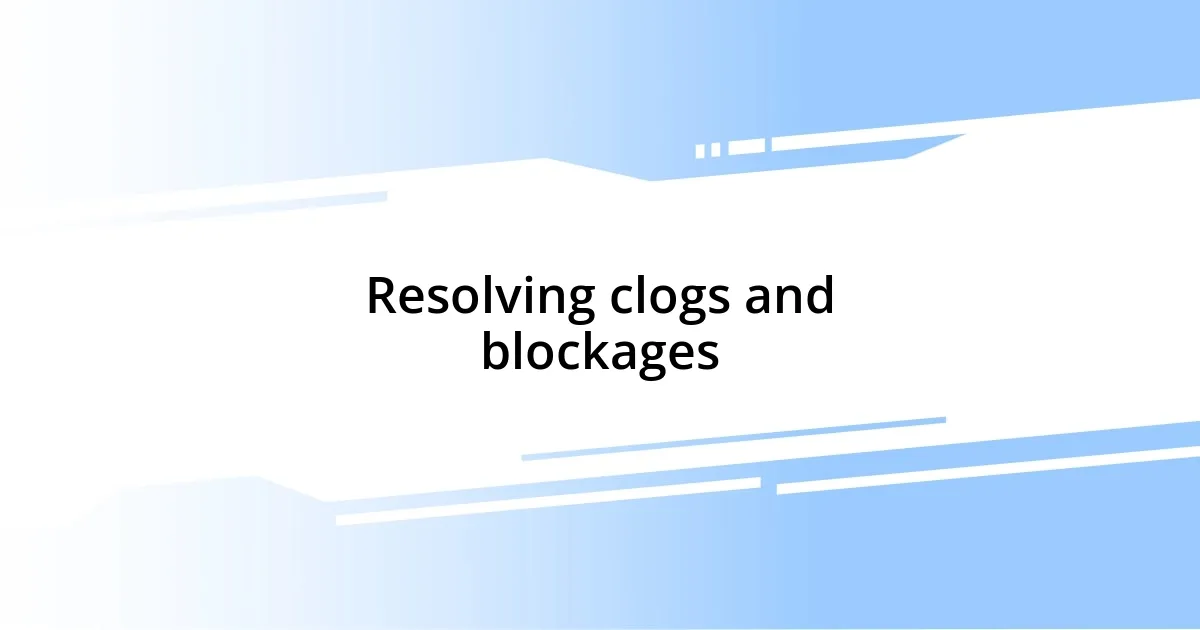Key takeaways:
- Common toilet problems include noisy toilets, leaks, and foul odors, which may indicate deeper issues needing prompt attention.
- Having the right tools, like a plunger and adjustable wrench, is essential for effective toilet repairs.
- A systematic troubleshooting approach, starting with turning off the water supply, helps manage repairs and avoid further issues.
- Know when to call a professional, especially for persistent problems or complex plumbing issues that DIY attempts cannot resolve.

Understanding common toilet problems
Toilets can seem straightforward, but they often reveal a myriad of problems. I’ve experienced the panic of a toilet that wouldn’t flush properly, and I’ll tell you, that moment of uncertainty can be quite unsettling. Have you ever had to deal with the embarrassment of an overflowing toilet? It’s not just a plumbing issue; it can feel like a personal crisis unfolding in your home.
One common problem I’ve encountered is the noisy toilet that gurgles or makes strange sounds long after you’ve flushed. At first, I thought it was just a quirky feature of my bathroom, but I soon learned it could indicate a venting issue or a clog somewhere in the system. Isn’t it fascinating how something so mundane can signal deeper problems? It’s essential to pay attention to those peculiar sounds, even if they initially seem harmless.
Then there’s the dreaded leak under the toilet, which I discovered during what I’d thought was a routine cleaning session. It was alarming to see water pooling around the base. That moment made me realize how neglecting minor leaks can lead to significant water damage and mold growth. How often do we overlook little signs, thinking they’ll resolve themselves? Trust me, addressing these small issues early on can save time, money, and a whole lot of stress down the line.

Identifying toilet issue symptoms
To identify toilet issues effectively, observing symptoms is crucial. For example, I once noticed a toilet that took an unusually long time to refill after flushing. This small delay might seem minor, but it pointed to an issue with the fill valve, which I learned can be an early indicator of more significant problems if ignored. Trust me, once I fixed it, the toilet worked like new again, and I was relieved I hadn’t let it slide.
Another symptom I encountered was the persistent foul odor emanating from the toilet area. Initially, I assumed it was just a matter of cleaning, but I quickly realized it might indicate a deeper problem, such as a blockage in the sewage line. The distress that comes from an unpleasant smell can be unsettling and distracting, as I’ve found it makes you second-guess your entire home environment. Addressing such odors promptly can save you from more extensive repairs later on.
Lastly, one of the more subtle symptoms I experienced was a toilet that would occasionally run on its own. At first, I brushed it off as a minor annoyance, but it revealed a malfunctioning flapper valve that could waste gallons of water if left unresolved. This realization struck me hard; it’s astonishing how a simple oversight can contribute to higher utility bills. It’s always better to fix those quirky little behaviors before they spiral into costly problems.
| Symptom | Possible Cause |
|---|---|
| Long refill time | Faulty fill valve |
| Foul odor | Sewage blockage |
| Running toilet | Malfunctioning flapper valve |

Tools needed for toilet repair
To tackle toilet repairs effectively, having the right tools on hand is essential. The first time I faced a toilet issue, I quickly realized that improvisation wouldn’t suffice. Finding the specific tools I needed made a world of difference, especially when the clock was ticking, and a family member was waiting for the bathroom!
Here’s a handy list of the tools you should gather before diving into toilet repairs:
- Adjustable Wrench: Great for loosening and tightening nuts around the toilet.
- Plunger: A must-have for clearing clogs.
- Toilet Auger: Perfect for reaching deeper blockages if the plunger doesn’t do the trick.
- Screwdriver Set: Useful for replacing or adjusting parts.
- Bucket and Towels: For catching any water spills and keeping the area dry.
- Replacement Parts: Such as flapper valves, fill valves, and wax rings, depending on your needs.
Having these at my fingertips felt empowering; it turned a daunting task into something manageable. I distinctly remember one rainy afternoon when I had to replace a stubborn flapper valve. With the right tools, I tackled the job with confidence, feeling like a mini plumber! Each tool served as a reminder that preparation can transform chaotic moments into manageable tasks.

Step by step troubleshooting process
Starting the troubleshooting process for toilet issues can feel overwhelming, but I’ve found a systematic approach makes it manageable. First, turn off the water supply to avoid any unpleasant surprises. I remember the first time I forgot to do this—it turned into an impromptu water fountain! Once that’s sorted, I recommend inspecting the toilet’s innards. Carefully lift the tank lid and evaluate components like the flapper, fill valve, and float for any visible issues.
Next, it’s time to test each part. For example, after replacing a worn flapper, I conducted a simple dye test by dropping some food coloring into the tank. Watching the color seep into the bowl confirmed whether I fixed the issue or if there was still a leak. This step is crucial not just for peace of mind but also to ensure that no water is wasted. Have you ever seen how much a small leak can rack up on your water bill? It’s eye-opening!
Finally, if the problem persists after these initial checks, there might be deeper plumbing issues at play. It can be a bit disheartening, but sometimes it’s a sign to reach out for professional help. I once struggled with a clog that seemed endless until I called in a plumber. What a relief that was! Sometimes knowing when to call in the pros, rather than wrestling alone, is part of effective troubleshooting.

Resolving clogs and blockages
When it comes to resolving clogs, my trusty plunger has been a lifesaver more times than I can count. I remember feeling a wave of panic when a particularly stubborn clog appeared after my family hosted a gathering. I grabbed the plunger, took a deep breath, and channeled all my energy into a firm push. It was exhilarating when I finally heard that satisfying gurgle. Nothing compares to the relief of seeing water swirling down the drain again!
However, sometimes the plunger isn’t enough to tackle those deeper blockages. I’ve had moments where frustration set in, and that’s when I pulled out the toilet auger. Poking and prodding deep into the toilet’s underbelly felt a bit like fishing—unpredictable yet oddly satisfying! I’ll never forget the moment I felt that final release as the auger caught and cleared the obstruction. It’s moments like those that remind me of the resilience we all have, don’t you think?
If you encounter a blockage that resists every technique, it’s essential to step back and assess. One time, I found myself in over my head after trying every DIY method I could think of. I learned my lesson when I finally called a professional to handle what turned out to be a build-up in the pipes. Trust me, sometimes it’s better to let an expert tackle the issue. Knowing when to ask for help is part of the journey, and it can save you a great deal of time and frustration. Have you ever faced a situation like that?

Fixing leaks and running toilets
Fixing leaks in a toilet can be less daunting than it initially seems. I recall tackling a persistent leak that left a small puddle on my bathroom floor. After a bit of googling and checking the fittings, I tightened the supply line connection, which turned out to be the culprit. The feeling of seeing that water stop flowing was a weight off my shoulders; it’s empowering to fix something with your own hands, wouldn’t you agree?
Running toilets are another common headache. I remember my frustration when my toilet wouldn’t stop flushing, incessantly wasting water. I discovered that the float was stuck. Gently jiggling it back into place restored the silence, and honestly, a sense of victory washed over me. There’s something incredibly satisfying about solving these issues, and the little savings on my water bill were just the cherry on top!
Yet, sometimes problems persist despite our best efforts. I once emulated a DIY hero, trying to replace all the parts in the tank myself. After hours of tinkering and countless YouTube videos, I finally had to surrender and call in a plumber when nothing changed. It was a humbling reminder that while I enjoy a good challenge, some issues genuinely require a professional touch. Have you ever pushed through something only to find that calling for help was the best move?














